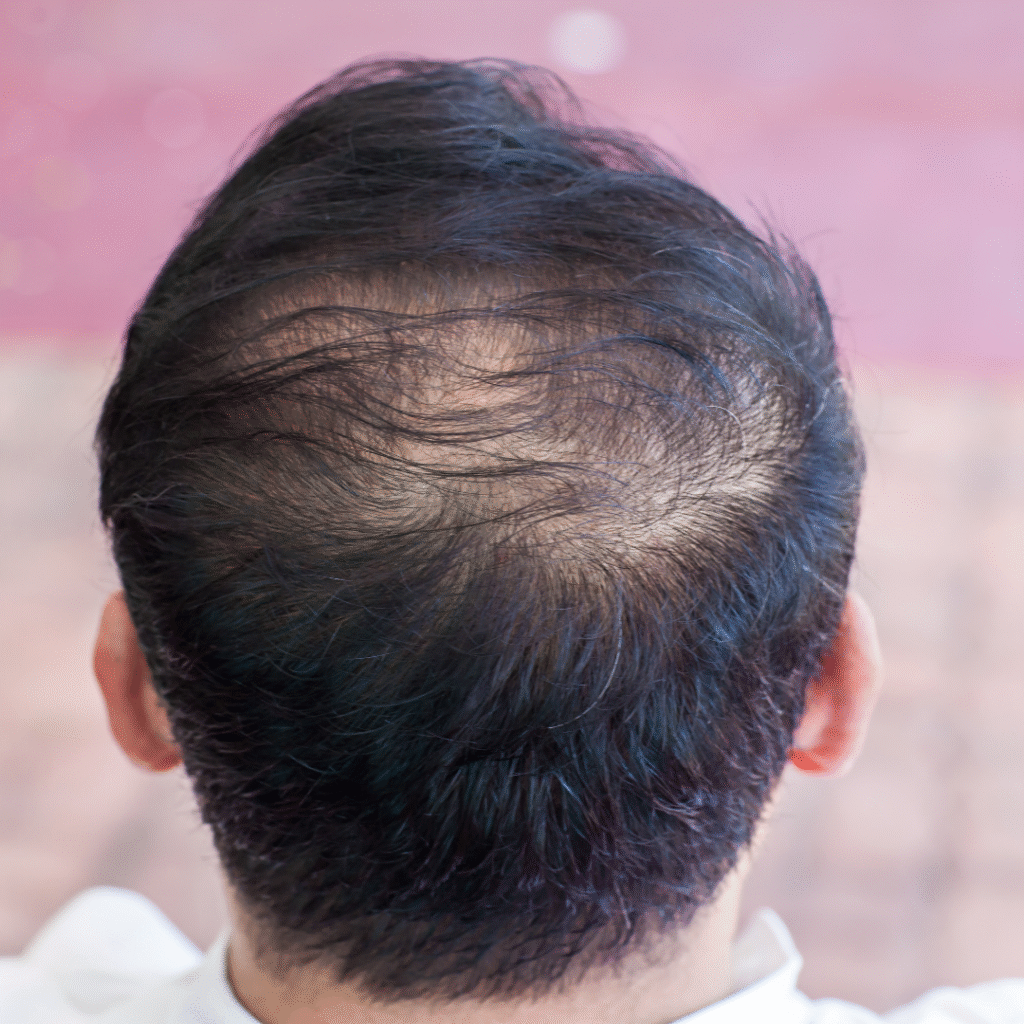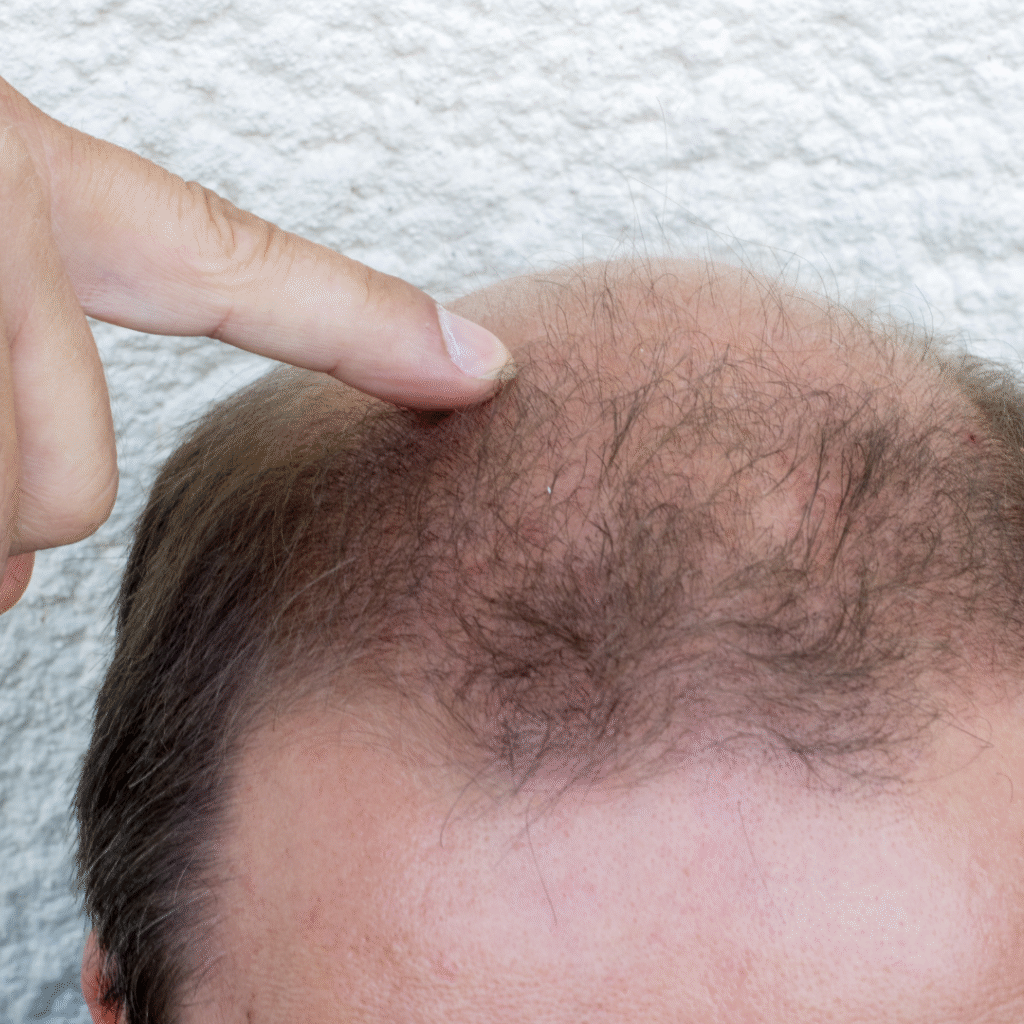
Introduction
Hair loss generally known as baldness or alopecia refers to a loss of a significant amount of hairs from scalp or beard or other body parts. As per new data, more than 50% of all the male population over the age of 30 started going bald or affected by androgenic alopecia / male pattern baldness or started having signs of it.
Symptoms and Causes
Symptoms of Male Hair Loss
Male hair loss usually develops gradually and can show different warning signs depending on the cause. Common symptoms include:
Thinning hair on the crown or top of the head.
Receding hairline that moves backward, often forming an “M” shape.
Patchy bald spots on the scalp, beard, or eyebrows.
Excessive hair shedding, especially after combing or washing.
Widening part lines or more visible scalp.
Weakened or finer hair strands compared to normal thickness.
In advanced cases, partial or complete baldness.
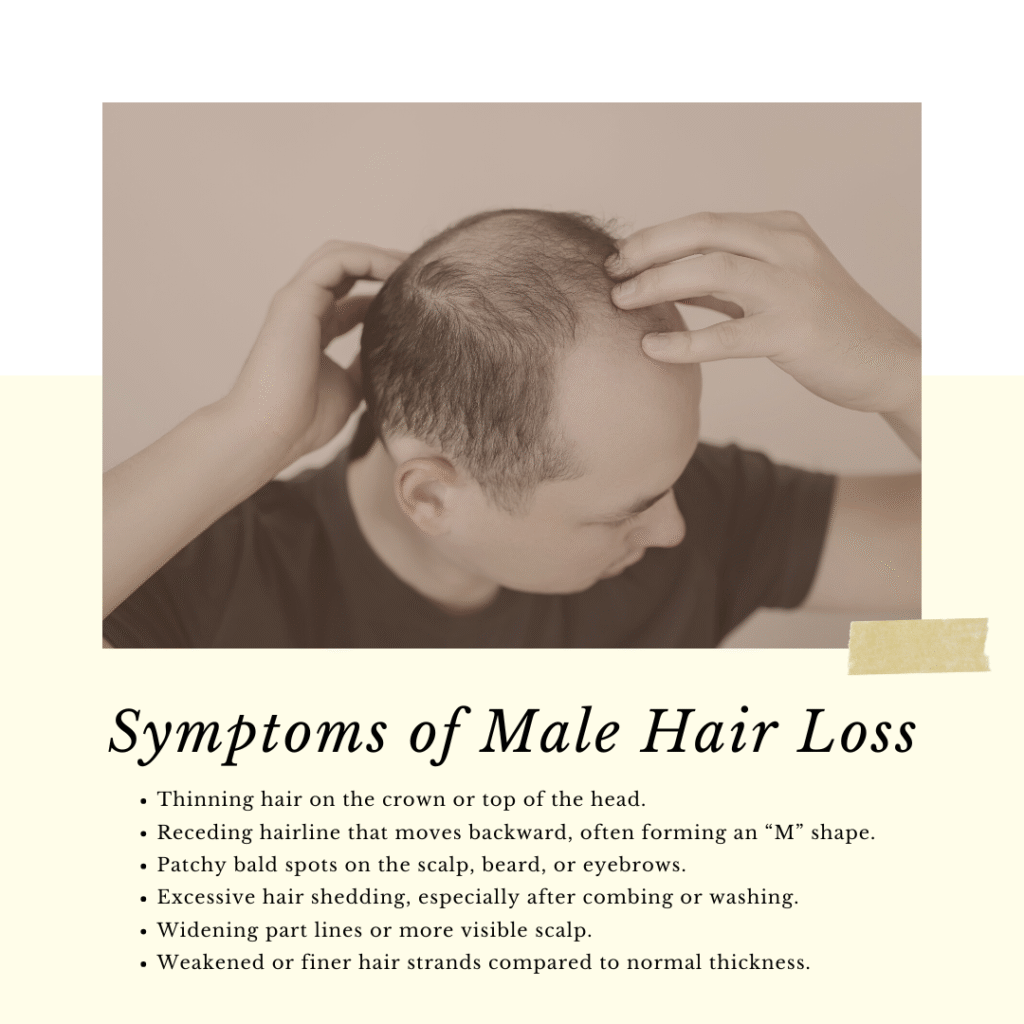
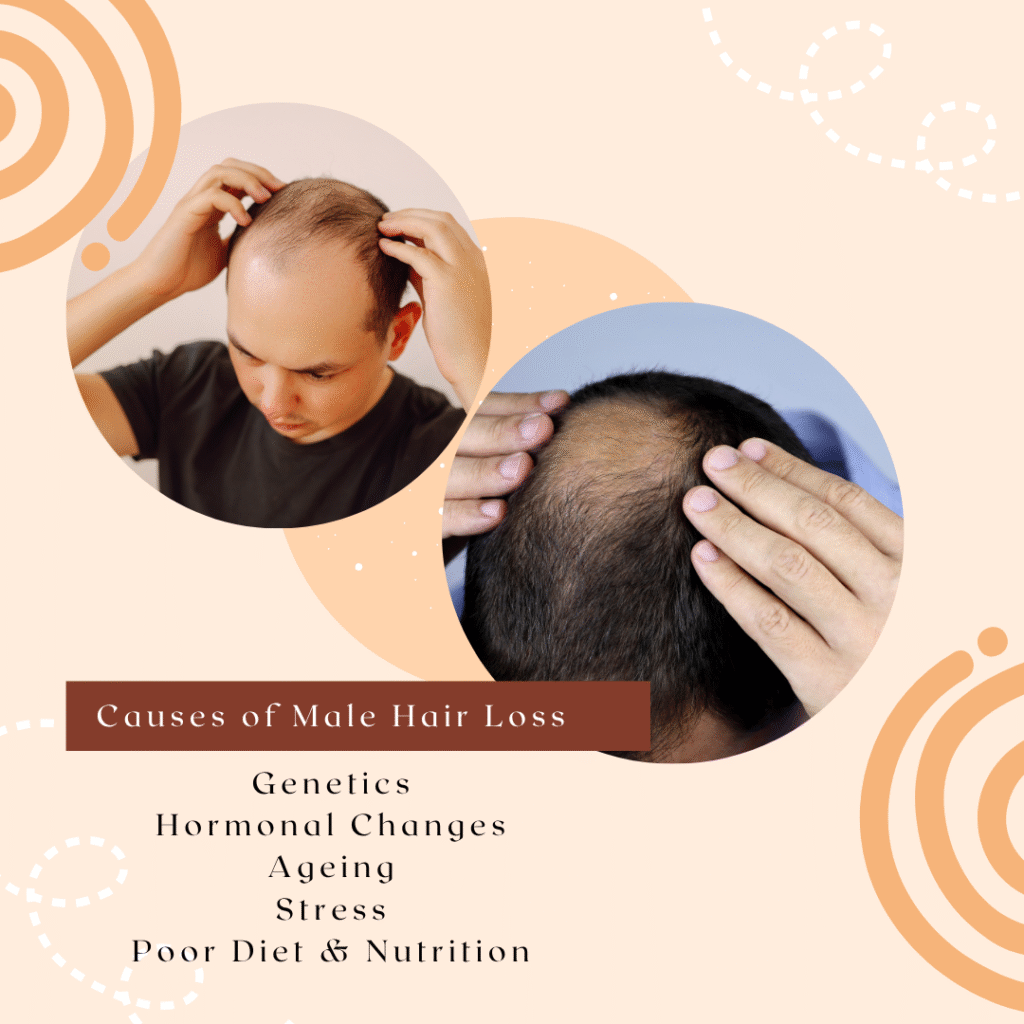
Causes of Male Hair Loss
Male hair loss can happen due to a mix of genetic, lifestyle, and health-related reasons. The most common causes include:
Genetics (Male Pattern Baldness): Hereditary hair loss is the leading cause, often starting with a receding hairline or thinning crown.
Hormonal Changes: Dihydrotestosterone (DHT), a byproduct of testosterone, shrinks hair follicles and slows hair growth.
Ageing: Natural aging weakens hair roots, leading to thinning and baldness over time.
Stress: Physical or emotional stress can trigger temporary hair shedding (telogen effluvium).
Poor Diet & Nutrition: Lack of proteins, vitamins (B12, D, biotin), and minerals like iron and zinc weakens hair growth.
Medical Conditions: Thyroid issues, autoimmune diseases, and scalp infections can cause hair loss.
Medications & Treatments: Certain drugs for blood pressure, depression, or cancer may result in hair thinning.
Lifestyle Habits: Smoking, alcohol, poor sleep, and excessive hairstyling damage hair follicles.
Types of Male Hair Loss
Male hair loss can occur in different patterns and conditions. The main types include:
Androgenetic Alopecia (Male Pattern Baldness): The most common type, caused by genetics and hormones. Starts with a receding hairline or thinning crown, progressing to partial or complete baldness.
Telogen Effluvium: Temporary hair shedding due to stress, illness, surgery, or nutritional deficiency. Hair usually grows back once the trigger is removed.
Alopecia Areata: An autoimmune condition where the immune system attacks hair follicles. Causes round bald patches on the scalp, beard, or body.
Traction Alopecia: Hair loss due to constant pulling or tight hairstyles (like ponytails, braids, or helmets). If untreated, it can lead to permanent follicle damage.

Treatment for Male Hair Loss
Male hair loss is a common condition that affects men of all ages, often beginning with a receding hairline, thinning crown, or excessive hair shedding. It can result from genetics, hormonal changes, stress, poor lifestyle habits, or medical conditions. Early symptoms include visible scalp, finer strands, and patchy bald spots. Treatments such as medications, PRP therapy, laser sessions, and hair transplants can help restore hair growth and confidence. Maintaining a healthy lifestyle and proper scalp care also play a key role. Identifying the cause early ensures better management and long-lasting results.
Medications
Platelet-Rich Plasma (PRP) Therapy
Low-Level Laser Therapy (LLLT)
Consult a Specialist Today
Many of the techniques for preventing pimples may also be used to cure them. Eating well, avoiding stress, and not popping pimples may help manage zits and reduce their length. If your acne continues despite your best efforts, you may need prescription acne treatment. Consult your dermatologist if you’re uncertain about treatment.
FAQ's
The most common cause is androgenetic alopecia (male pattern baldness), influenced by genetics and hormones. Other causes include stress, poor diet, medications, or medical conditions.
Hair loss can begin as early as the late teens or early 20s, but it is most noticeable in men by their 30s and 40s.
While genetic hair loss cannot be fully prevented, a healthy lifestyle, stress management, and early treatment can slow down progression.
Options include medications (minoxidil, finasteride), PRP therapy, laser treatment, hair transplants, and lifestyle changes.
Genetic hair loss is usually permanent without treatment, but other causes (like stress or nutrient deficiency) may lead to temporary hair loss that can be reversed.
Triggers of baldness
1. Hereditary hair loss Most common cause of hair loss worldwide. In men and women, it’s called male pattern hair loss, female pattern hair loss respectively. The medical term is androgenic alopecia. An inherited gene causes your hair follicles to shrink and eventually stop growing hair. Shrinking can begin as early as your teens, but it usually starts later in life. In women, the first noticeable sign is overall thinning or a widening part. In man, the first sign is a receding hairline or bald spot at the top of his head.
2. Age loss With age, most people notice some hair loss because hair growth slows. As hair follicles stop growing hair, it causes the hair on our scalp to thin. Hair starts to lose its color. A woman’s hairline naturally starts to recede.
3. Hair careIf you color, perm, or relax your hair, you could be damaging your hair. Over time, this damage can lead to hair loss
4. Medication A possible side effect of some medications is hair loss. If you think a medication is causing your hair loss, ask the doctor who prescribed it if hair loss is a possible side effect.
It’s essential that you do not stop taking the medication before talking with your doctor. Abruptly stopping some medications can cause serious health problems.
5. Scalp psoriasis Many people who have plaque psoriasis develop psoriasis on their scalp at some point. This can lead to hair loss.
6. Scalp infection A scalp infection can lead to scaly and sometimes inflamed areas on your scalp. You may see what look like small black dots on your scalp. These are actually stubs of hair. Some people develop a bald spot.
7. Low Energy Levels The body’s ability to convert the food we eat to energy is what determines how much or how less energy we have. This is called metabolism. A good metabolism is required for the body to break down nutrients from food and supply them through the blood to the follicles.
If the metabolism is slow that means most of the body’s energy is being utilized to break down nutrients and supply them to other parts of the body other than hair. This is when hair gets neglected and causes DHT to carry out its regular activity of causing hair thinning in men.
8. Hormonal Imbalance The fact that hormonal issues cause hair fall is something that is new to everyone. Conditions like PCOS, thyroid imbalance, diabetes, menopause, and pregnancy all involve fluctuating hormones, and along with other hormones, it also takes a toll on the hormone DHT which causes it to spike and leads to severe hair shedding. In reality, hormonal-triggered hair loss is one of the leading causes of genetic hair loss.
9. Nutritional Deficiencies Hair needs food too. Biotin, iron, zinc etc as in all macro and micro nutrients are required by hair for it to grow in an ideal manner.
This means that when any of these nutrients falls short in the body, it aggravates the hormone DHT and the excess of it has a negative effect on the hair strands and reflects as hair thinning along with looking dull, lifeless.
10. Lack of sleep The Circadian cycle also called the sleep-wake cycle plays an important role in hair health. This is why sleep is of utmost importance when it comes to literally any organ activity.
Irregular sleeping patterns also aggravate stress and cause hair thinning. A hormone called melatonin is released during sleep which is very essential for the smooth functioning of the hair cycle.
This melatonin also works against DHT – the main hormone responsible for hair fall where it causes DHT to unbind from the hair follicle receptors. Lastly, if melatonin is not produced in equal amounts due to not getting proper 8 hours of sleep, this can hamper the cycle and cause genetic hair loss.
11. Stressful Events When stress builds up in the body, cortisol a.k.a the stress hormone takes control. Be it work stress, the loss of a loved one, or a serious traumatic event, in other words, both short-term and chronic stress hampers the regular functioning of the hair growth cycle and causes hair loss.
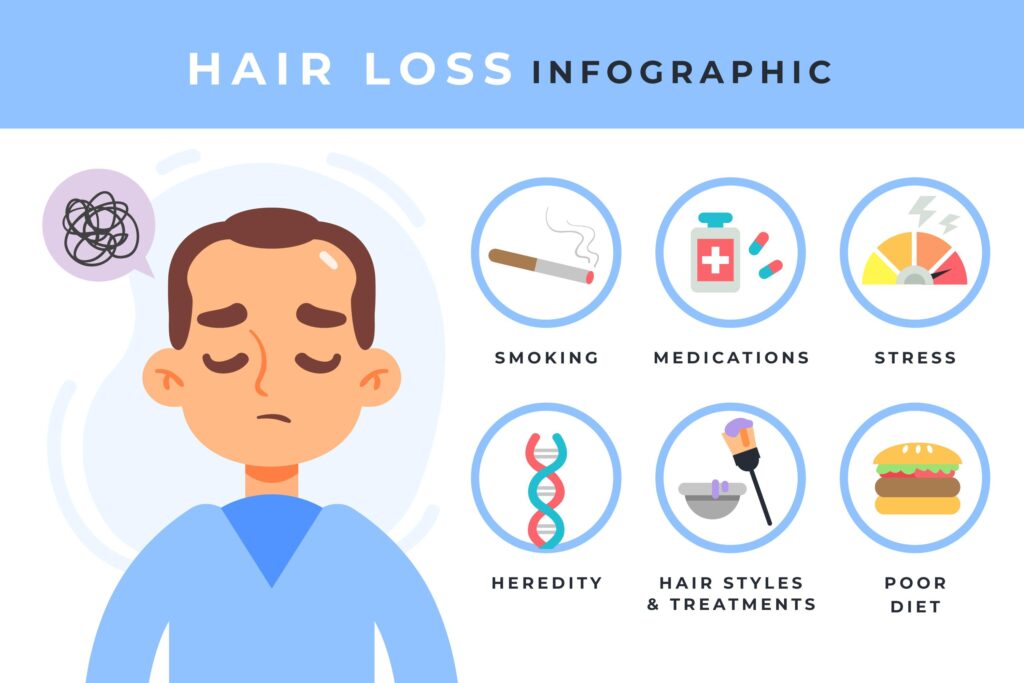

Signs or symptoms of male pattern hair loss
- More than usual hair fall / hair shedding per day
- Hair density thinning in front to top crown area
- Receding hairline from the corners
- Sudden hair loss
- Bald patch or skin visibility increased on crown area
- Increased Scalp itchiness or dandruff triggered more frequently
- Poor or slow growth of hair follicles
Classification of Male Pattern Hair Loss:
Norwood and Hamilton are the scientific researchers and doctors have analyzed the typical sequence in which people suffer from the male pattern baldness.
They noticed that hair loss initially leads to thinning of the frontal and temporal area of the hairline and then starts receding towards the crown. Which is known as the early stage/ level of baldness. Later on, at the top of the scalp, crown area also starts thinning and showing bald patches or areas which gradually merge with the front baldness zone with age. When the front and crown are merged, this stage or baldness is known as the advance stage of baldness.
Classification of Male Pattern Hair Loss:


Why is it important to know the stage or level of baldness?
Because the treatment plan or prevention of baldness are set according to the level of baldness, if someone is in the initial early stage of baldness that is grade 1-2-3, there are still chances he may recover his lost hair growth or density through medical management if done on time.
If someone is at an advanced stage, it’s not possible to recover full scalp from baldness and to get such an outcome he may need to go under hair transplant procedure as well along with routine medical management.



